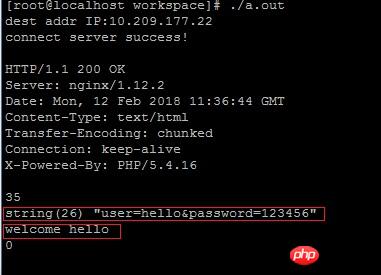PHP後台與手機APP介面開發實例代碼
本文主要和大家分享PHP後台與手機APP介面開發實例程式碼,希望能幫助大家
一、手機APP(客戶端)程式介面
這裡採用在PC上使用C++程式模擬HTTP協定資料的POST
#include <iostream>
#include <fstream>
#include <cstdlib>
#include <cstring>
#include <sys/socket.h>
#include <netinet/in.h>
#include <arpa/inet.h>
#include <sys/types.h>
#include <unistd.h>
using namespace std;
#define DEST_IP "10.209.177.22"
#define DEST_PORT 80
#define MAX_DATA_SIZE 1024
int main()
{
int ret;
int sockfd;
struct sockaddr_in dest_addr;
memset(&dest_addr, 0x00, sizeof(sockaddr_in));
dest_addr.sin_family = AF_INET;
dest_addr.sin_addr.s_addr = inet_addr(DEST_IP);
dest_addr.sin_port = htons(DEST_PORT);
cout << "dest addr IP:" << inet_ntoa(dest_addr.sin_addr) << endl;
sockfd = socket(AF_INET, SOCK_STREAM, IPPROTO_TCP);
if (sockfd < 0) {
cout << "create socket fail!" << endl;
exit(1);
}
ret = connect(sockfd, (struct sockaddr *)&dest_addr, sizeof(struct sockaddr));
if (ret != 0) {
cout << "connect server fail!" << endl;
close(sockfd);
exit(1);
} else {
cout << "connect server success!" << endl;
}
cout << endl;
int sendlen, recvlen;
char sendbuf[MAX_DATA_SIZE] = {0};
char recvbuf[MAX_DATA_SIZE] = {0};
string body("user=hello&password=123456");
int content_length = body.length();
snprintf(sendbuf, sizeof(sendbuf) - 1,
"POST /api.php HTTP/1.1\r\n"
"Host: 10.209.177.22\r\n"
"Content-Type: application/x-www-form-urlencoded\r\n"
"Content-Length: %d\r\n",
content_length
);
strcat(sendbuf, "\r\n");
strcat(sendbuf, body.c_str());
sendlen = send(sockfd, sendbuf, sizeof(sendbuf), 0);
if (sendlen < 0) {
cout << "send fail" << endl;
close(sockfd);
exit(1);
}
if ((recvlen = recv(sockfd, recvbuf, sizeof(recvbuf), 0)) == -1) {
cout << "recv fail" << endl;
close(sockfd);
exit(1);
} else {
cout << recvbuf << endl;
}
close(sockfd);
return 0;
}二、後台PHP測試程式
<?php
$input = file_get_contents("php://input");
var_dump($input);
if ($_POST['user'] == "hello" && $_POST['password'] == "123456") {
echo "welcome hello";
} else {
echo "welcome guest";
}
?>三、實作效果

說明:只能接收Content-Type: application/x-www-form-urlencoded提交的資料。
解釋:也就是表單POST過來的資料。
方法2、file_get_contents("php://input");
說明:
允許讀取 POST 的原始資料。
和 $HTTP_RAW_POST_DATA 比起來,它給記憶體帶來的壓力較小,並且不需要任何特殊的 php.ini 設定。
php://input 不能用於 enctype="multipart/form-data"。
解釋:
對於未指定 Content-Type 的POST數據,則可以使用file_get_contents(“php://input”);來取得原始資料。
事實上,用PHP接收POST的任何資料都可以使用本方法。而不用考慮Content-Type,包括二進位檔案流也可以。
總是產生 $HTTP_RAW_POST_DATA 變數包含有原始的 POST 資料。
此變數僅在碰到未識別 MIME 類型的資料時產生。
$HTTP_RAW_POST_DATA 對於enctype="multipart/form-data" 表單資料不可用
如果post過來的資料不是PHP能夠辨識的,可以用$GLOBALS['HTTP_RAW_POST_DATA']來接收,
例如text /xml 或soap 等等
解釋:
$GLOBALS['HTTP_RAW_POST_DATA']存放的是POST過來的原始資料。
$_POST或$_REQUEST存放的是 PHP以key=>value的形式格式化以後的資料。
<!DOCTYPE>
<html>
<body>
<form method="post" action="" enctype="multipart/form-data">
<input type="file" name="file" id="file" />
<input type="submit" value="submit" />
</form>
<?php
echo "<pre class="brush:php;toolbar:false">";
print_r($_FILES);
if ($_FILES["file"]["error"] > 0) {
echo "Error: " . $_FILES["file"]["error"] . "<br>";
} else {
$file = fopen($_FILES["file"]["tmp_name"], "r");
while (!feof($file)) {
echo fgetc($file);
}
fclose($file);
}
?>
</body>
</html>以上是PHP後台與手機APP介面開發實例代碼的詳細內容。更多資訊請關注PHP中文網其他相關文章!

熱AI工具

Undresser.AI Undress
人工智慧驅動的應用程序,用於創建逼真的裸體照片

AI Clothes Remover
用於從照片中去除衣服的線上人工智慧工具。

Undress AI Tool
免費脫衣圖片

Clothoff.io
AI脫衣器

Video Face Swap
使用我們完全免費的人工智慧換臉工具,輕鬆在任何影片中換臉!

熱門文章

熱工具

記事本++7.3.1
好用且免費的程式碼編輯器

SublimeText3漢化版
中文版,非常好用

禪工作室 13.0.1
強大的PHP整合開發環境

Dreamweaver CS6
視覺化網頁開發工具

SublimeText3 Mac版
神級程式碼編輯軟體(SublimeText3)
 適用於 Ubuntu 和 Debian 的 PHP 8.4 安裝和升級指南
Dec 24, 2024 pm 04:42 PM
適用於 Ubuntu 和 Debian 的 PHP 8.4 安裝和升級指南
Dec 24, 2024 pm 04:42 PM
PHP 8.4 帶來了多項新功能、安全性改進和效能改進,同時棄用和刪除了大量功能。 本指南介紹如何在 Ubuntu、Debian 或其衍生版本上安裝 PHP 8.4 或升級到 PHP 8.4
 如何設定 Visual Studio Code (VS Code) 進行 PHP 開發
Dec 20, 2024 am 11:31 AM
如何設定 Visual Studio Code (VS Code) 進行 PHP 開發
Dec 20, 2024 am 11:31 AM
Visual Studio Code,也稱為 VS Code,是一個免費的原始碼編輯器 - 或整合開發環境 (IDE) - 可用於所有主要作業系統。 VS Code 擁有大量針對多種程式語言的擴展,可以輕鬆編寫
 在PHP API中說明JSON Web令牌(JWT)及其用例。
Apr 05, 2025 am 12:04 AM
在PHP API中說明JSON Web令牌(JWT)及其用例。
Apr 05, 2025 am 12:04 AM
JWT是一種基於JSON的開放標準,用於在各方之間安全地傳輸信息,主要用於身份驗證和信息交換。 1.JWT由Header、Payload和Signature三部分組成。 2.JWT的工作原理包括生成JWT、驗證JWT和解析Payload三個步驟。 3.在PHP中使用JWT進行身份驗證時,可以生成和驗證JWT,並在高級用法中包含用戶角色和權限信息。 4.常見錯誤包括簽名驗證失敗、令牌過期和Payload過大,調試技巧包括使用調試工具和日誌記錄。 5.性能優化和最佳實踐包括使用合適的簽名算法、合理設置有效期、
 php程序在字符串中計數元音
Feb 07, 2025 pm 12:12 PM
php程序在字符串中計數元音
Feb 07, 2025 pm 12:12 PM
字符串是由字符組成的序列,包括字母、數字和符號。本教程將學習如何使用不同的方法在PHP中計算給定字符串中元音的數量。英語中的元音是a、e、i、o、u,它們可以是大寫或小寫。 什麼是元音? 元音是代表特定語音的字母字符。英語中共有五個元音,包括大寫和小寫: a, e, i, o, u 示例 1 輸入:字符串 = "Tutorialspoint" 輸出:6 解釋 字符串 "Tutorialspoint" 中的元音是 u、o、i、a、o、i。總共有 6 個元
 您如何在PHP中解析和處理HTML/XML?
Feb 07, 2025 am 11:57 AM
您如何在PHP中解析和處理HTML/XML?
Feb 07, 2025 am 11:57 AM
本教程演示瞭如何使用PHP有效地處理XML文檔。 XML(可擴展的標記語言)是一種用於人類可讀性和機器解析的多功能文本標記語言。它通常用於數據存儲
 解釋PHP中的晚期靜態綁定(靜態::)。
Apr 03, 2025 am 12:04 AM
解釋PHP中的晚期靜態綁定(靜態::)。
Apr 03, 2025 am 12:04 AM
靜態綁定(static::)在PHP中實現晚期靜態綁定(LSB),允許在靜態上下文中引用調用類而非定義類。 1)解析過程在運行時進行,2)在繼承關係中向上查找調用類,3)可能帶來性能開銷。
 什麼是PHP魔術方法(__ -construct,__destruct,__call,__get,__ set等)並提供用例?
Apr 03, 2025 am 12:03 AM
什麼是PHP魔術方法(__ -construct,__destruct,__call,__get,__ set等)並提供用例?
Apr 03, 2025 am 12:03 AM
PHP的魔法方法有哪些? PHP的魔法方法包括:1.\_\_construct,用於初始化對象;2.\_\_destruct,用於清理資源;3.\_\_call,處理不存在的方法調用;4.\_\_get,實現動態屬性訪問;5.\_\_set,實現動態屬性設置。這些方法在特定情況下自動調用,提升代碼的靈活性和效率。
 PHP和Python:比較兩種流行的編程語言
Apr 14, 2025 am 12:13 AM
PHP和Python:比較兩種流行的編程語言
Apr 14, 2025 am 12:13 AM
PHP和Python各有優勢,選擇依據項目需求。 1.PHP適合web開發,尤其快速開發和維護網站。 2.Python適用於數據科學、機器學習和人工智能,語法簡潔,適合初學者。






